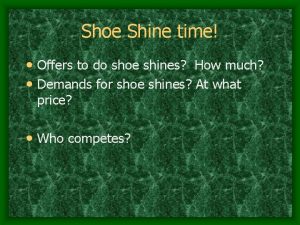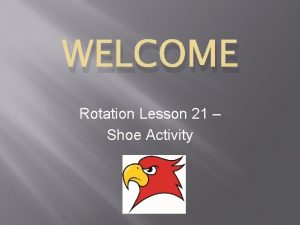History of the Running Shoe Running as a











- Slides: 11

History of the Running Shoe

Running as a sport can be traced back to the ancient Greeks, who advocated a culture based on sound bodies and sound minds. During Greek athletic contests, runners competed barefoot and often naked. Later, the Romans mandated that their messengers wear thin-soled sandals. As shoemaking evolved through the centuries, leather became and The first references to remained the favored material shoes designed specifically because of its durability. for running don't appear until 1852, when historians noted a race in which runners wore shoes with spiked soles.

When Charles Goodyear came up with vulcanized rubber in 1839 it was used in the making of an all purpose athletic shoe known as the sneaker. The process was then rejected because it was not durable and running shoes were made out of leather again.

A Scotsman known as "Old Man" Richings provided some relief when he invented a customized shoe designed with a seamless toe box (a piece of material inserted between the toe cap and the shoe lining and treated with a hardening agent, the toe box protects the toes against rubbing).

Adolf Dassler • In 1925, Adolph Dassler, a German shoemaker, decided to concentrate on athletic shoes, and founded a business with his brother, Rudolph, to do so. The Dasslers' running shoes provided both arch support and speed lacing, and their high-quality products attracted prominent athletes including some Olympians: Jesse Owens is reported to have worn Dassler shoes during the 1936 games in Munich.

• During the 1960 s, a company called New Balance began to examine how running impacts the foot. As a result of this research, New Balance developed an orthopedic running shoe with a rippled sole and wedge heel to absorb shock. As running became more popular and joggers more knowledgeable, the demand for footwear that would help prevent injuries increased.

In 1972 Bill Bowerman made the first lightweight outsole shoe from some latex, leather, glue and his wife’s waffle iron. His shoe was unique because it provided optimal grip on surfaces.

5 parts found in a running shoe today • The outsole: This is the treaded layer on the undersurface of the shoe, usually made from carbon rubber or similar material. It resists wears and provides traction. It may also have a studded or waffle design to enhance traction on softer surfaces. The midsole: This is considered the most important part of running shoes as it is the cushioning and stability layer between the upper and the outsole. The most common materials for the midsole of running shoes is ethylene vinyl acetate (EVA), polyurethane (PU) or a combination of the two. Often there is a dual-density midsole that has a firmer material on the inner side (medial side) to help limit pronation (rolling in) of the foot. A lot of proprietary technologies developed by different manufacturers go into the midsoles of running shoes (eg air, gel and high-tech plastics materials). The upper: This is the part of the shoe that wraps around and over the top of the foot. It may be made of leather or a synthetic material that is lighter and breathable (to reduce heat from inside the running shoe). The tongue of the upper should be padded to cushion the top of the foot against the pressure from the laces. Often, at the back of the running shoe, the upper is padded to prevent rubbing and irritation against the achilles tendon. The heel counter: This is a firm and inflexible cup which is built into the upper of running shoes and surrounds the heel. It is usually very firm so that it can control motion of the rearfoot. Post or footbridge: This is the firm material in the midsole which increases stability along the inner side (arch side; medial side) of the running shoe.

• To make running shoes better today companies are designing the shape and feel around some factors like: • Impact reduction • Traction • Weight • flexibility

Flywire • Running shoes today are being made with ground breaking technologies like flywire. • Nike Flywire is a thread, composed of vectran, and developed by Nike, used in the Upper of a shoe. The goal of Flywire is to minimize weight and maximize support.

The On Running Shoe • Swiss engineer set about creating a shoe that enabled the runner to land as soft as if running on sand, and to push off as if running in track shoes. • It is a shoe that incorporates a unique rubber ring into the sole design to provide a soft landing, while offering firmness and stability on push off. • The shoe tries to activate postural muscles. • The shoe will be unveiled on February 7 -10, 2010.
 Running running running
Running running running Once upon a time there lived a boy
Once upon a time there lived a boy Running shoe tongue slides
Running shoe tongue slides Running horned woman ap art history
Running horned woman ap art history ưu thế lai là gì
ưu thế lai là gì Các môn thể thao bắt đầu bằng tiếng nhảy
Các môn thể thao bắt đầu bằng tiếng nhảy Tư thế ngồi viết
Tư thế ngồi viết Cái miệng xinh xinh thế chỉ nói điều hay thôi
Cái miệng xinh xinh thế chỉ nói điều hay thôi Hát kết hợp bộ gõ cơ thể
Hát kết hợp bộ gõ cơ thể Cách giải mật thư tọa độ
Cách giải mật thư tọa độ Từ ngữ thể hiện lòng nhân hậu
Từ ngữ thể hiện lòng nhân hậu Tư thế ngồi viết
Tư thế ngồi viết





















